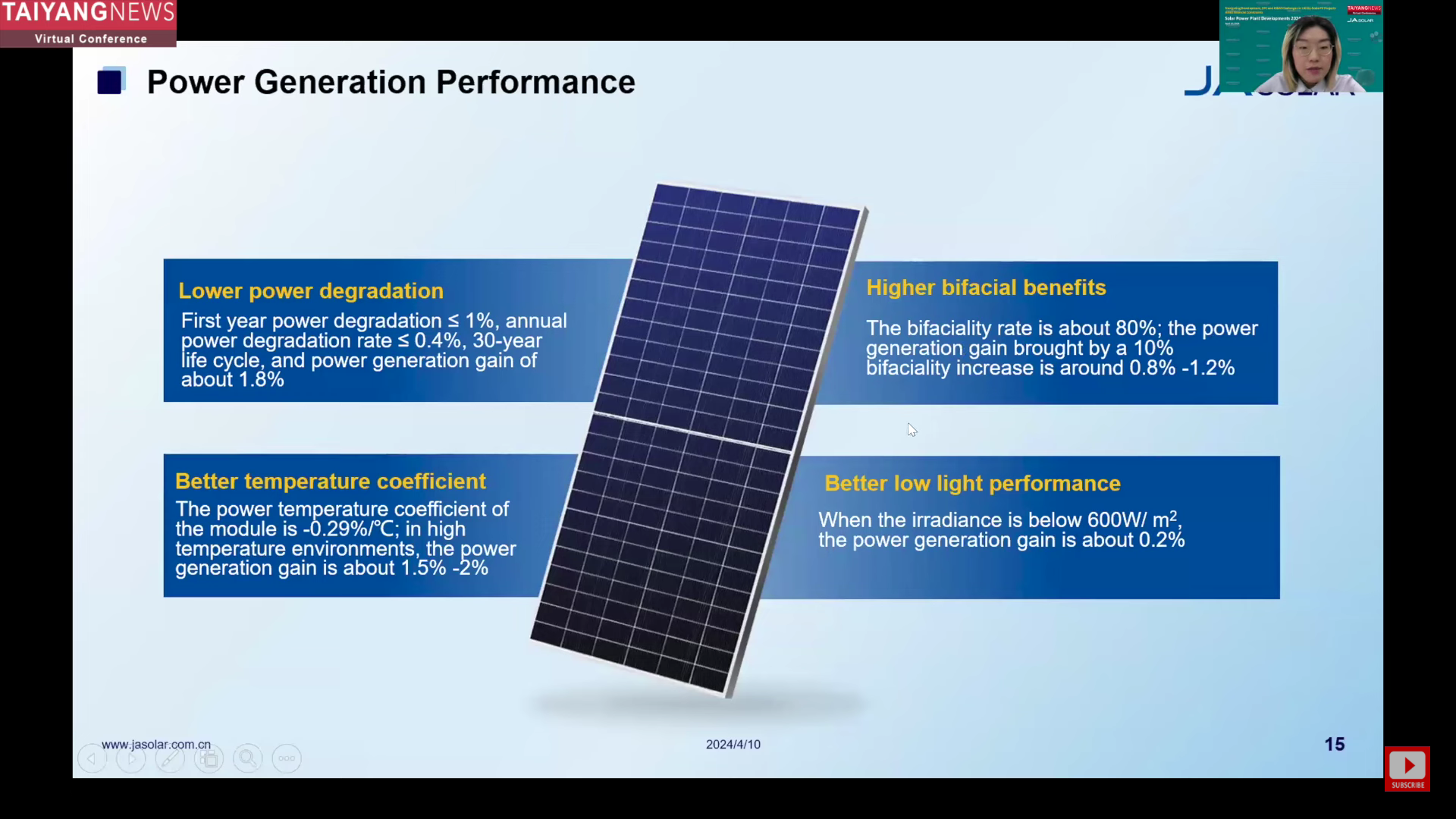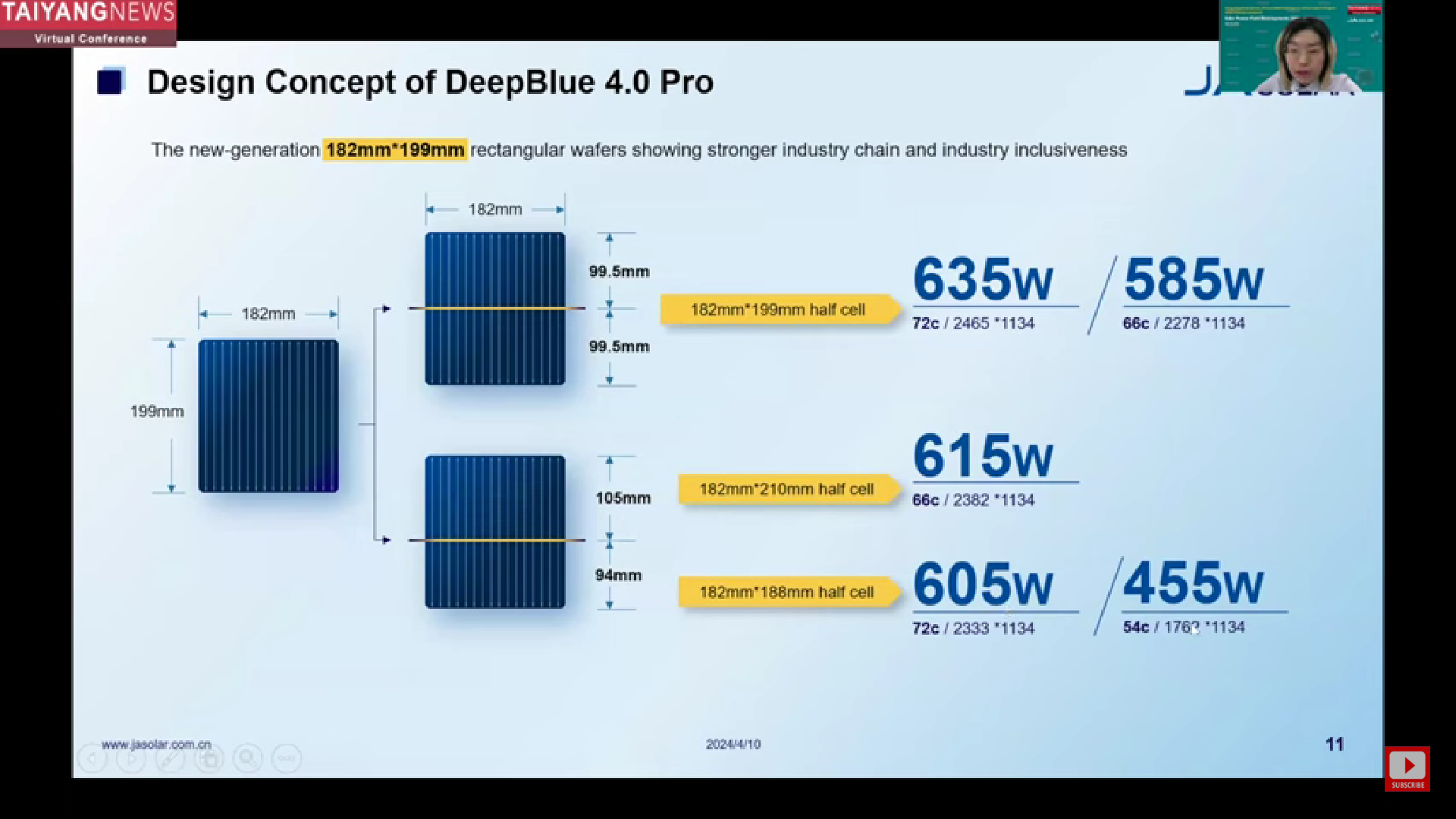- Based on the symmetrical and asymmetrical cutting of a single wafer size – 182 x 199 mm –the DeepBlue series has 5 different bifacial modules suitable for multiple applications
- The use of a single wafer size for producing different module sizeshelps prevent the waste of resources in the integrated manufacturing processes and eases the procuring process
- The module features other advanced features such as SMBB using 16-busbars and high-density encapsulation
In this era of high-efficiency n-type cell technologies, TOPCon is the current market favorite. JA Solar is a staunch advocate of the TOPCon technology and made several advancements to the technology such as rectangular wafers, a 16BB busbar layout, and high-density encapsulants. These developments have contributed to a diverse range of higher power class module series. At the TaiyangNews Virtual Conference on Solar Power Plant Developments 2024, Xueshan Yang, Product Manager at JA Solar,delved into evolving trends in advanced PV module design and their value to customers (see JA Solar’s presentation here).
Yang commenced by outlining the industrial trends that have seen the solar industry transition into the n-type era. Since 2022, when the industry first pivoted to n-type modules, 2023 emerged as the defining year for this technology. By 2024, the absence of n-type products in a company’s portfolio could significantly diminish its competitiveness. The demand for n-type modules is anticipated to continue dominating the market, with increasing outputs noted—modules delivering 600 W and even 700 W are now becoming standard. Additionally, while n-type TOPCon technologies are advancing, other cell technologies like HJT and XBC are also reaching the mass production stage. Despite challenges such as HJT’s UV sensitivity and XBC’s low bifaciality, overcoming these could usher in a new generation of cell technologies.
Advanced Module Design
In the second part of her presentation, Yang delved into how JA Solar is navigating these industry shifts. She likened the cell’s role in a PV module to the CPU in a computer, underscoring its importance in achieving high module power and efficiency. JA Solar’s advanced cell technology combinations have successfully attained over 26% efficiency in mass production, with an open circuit voltage surpassing 733 mV, a figure that stands out in the industry. She also highlighted the synergy between advanced cells and module technologies, ensuring optimal cell performance. The use of JA’s unique 199-rectangular wafer, combined with SMBB and high-density encapsulant technologies, not only boosts power output but also enhances module reliability compared to traditional square wafers. This configuration maximizes cell utilization within the module, minimizes shading and resistive losses, and reduces the impact of broken fingers on electrical performance.
Cutting the wafer is the trick
A true unique attribute is that JA Solar has developed 3 different module formats and 5 module sizes to adapt to the demands of different application scenarios such as residential, C&I, and utility, based on one wafer format—199 R; to be specific, 182 x 199 mm. One module format is based on cutting the cells into 2 symmetrical pieces along the longer length of 199 mm into 99.5 mm each. Based on this, JA Solar is able to build 2 module sizes with lengths of 2,465 mm and 2,278 mm, while the width remains the same at 1,134 mm. The larger one, built with 144 half cells, can reach power ratings of up to 635 W and 22.8% efficiency. The 2,278 mm module, using 132 cells, reached a power rating of 585 W and an efficiency of 22.7%. Cutting the same cell asymmetrically, i.e., one with a height of 105 mm and another with 94 mm, resulted in each size enabling one module format by itself. The 105 mm cell format is used to build a 615 W module with a 132 half-cell configuration that can reach up to 22.8% efficiency. The 94 mm cell strip is used as the basis for 2 module products; one with 144 half cells realizing 605 W and another with 108 half cells reaching 455 W. The use of a single wafer size for producing different module sizes, according to Yang, brings multiple benefits, including preventing the waste of resources in the integrated manufacturing processes of silicon ingots, wafers, and cells. Additionally, it allows for the selection of tools and materials with similar specifications, which eases the procuring process.

The next technical advancement associated with the DeepBlue 4.0 product range is the super multi-busbar (SMBB) layout with 16 busbars, which not only reduces the shading and resistive losses but also reduces the impact of the broken fingers and microcracks. High-density encapsulation involving small-spacing interconnection is yet another important attribute of the DeepBlue 4.0 series, which contributes to power improvement, product yield, and reliability, according to Yang.
System-level benefits
The product series comes with generic advantages of TOPCon modules such as lower power degradation, higher bifaciality, better temperature coefficient, and better low-light performance. DeepBlue has a 1st-year degradation of below 1% and linear annual degradation of less than 0.4%, which Yang attributes to a 1.8% additional electricity generation in the 30-year life span of the module. The low temperature coefficient of -0.29 %/°C would generate about 1.5% to 2% additional power even under very high-temperature operating conditions. Another point that adds up in terms of the energy yield is the high bifaciality of 80%, which is expected to translate into 0.8% to 1.2% additional power generation, according to Yang. However, the exact power yield gain is site-specific, depending on the latitude and ground albedo.

Yang also highlights the superior low-light response of its modules, especially at less than 600 W/m2 irradiance levels. During early mornings or late evenings with around 400 W/m2 irradiance, DeepBlue 4.0 Pro delivers about 0.2% gain in energy yield, claims Yang. The module series has also passed several in-house and 3rd party reliability testing protocols, demonstrating higher resilience in varied and severe environmental conditions. This makes the modules suitable for diverse application scenarios, which is increasingly becoming a module designing criterion. Different applications require different characteristics, thus an optimized BOM. Yang explains with an example of installations at airports or highways, which might need anti-glare glass to reduce the light reflection.
The rectangular wafer-based modules, especially the 144-cell based JAM72D42/LB with 7.69% lower Voc compared to industry mainstream 182-78-cell module of the same dimensions, allow additional modules to be installed in a single string along with the reduced risk of hotspots in the system. Yang presented the company’s internal assessment taking the example of a 130 MW project in Northwest China in 1P tracking configuration. Its flagship 635 W bifacial JAM72D42/LB model, compared to 182n-72c-580 modules, can bring down BOS costs for this project by up to 5.48%, which translates into 1.52% lower LCOE. Similarly, it reduces the LCOE for a 6 MW C&I and a 20 kW rooftop project by up to 1.68% and 4.69%, respectively.


